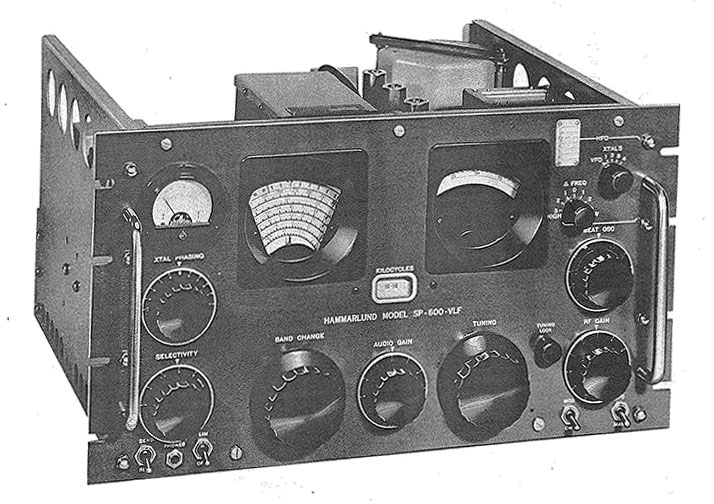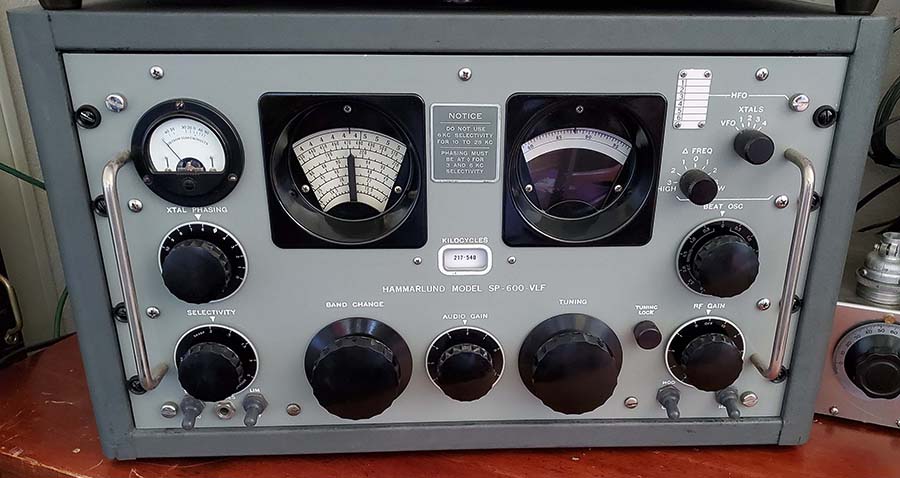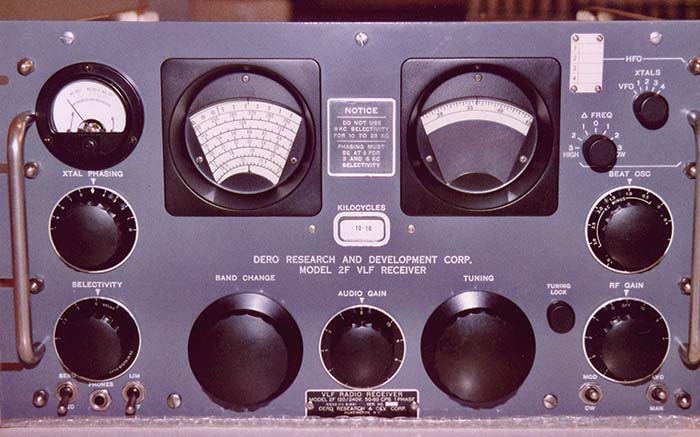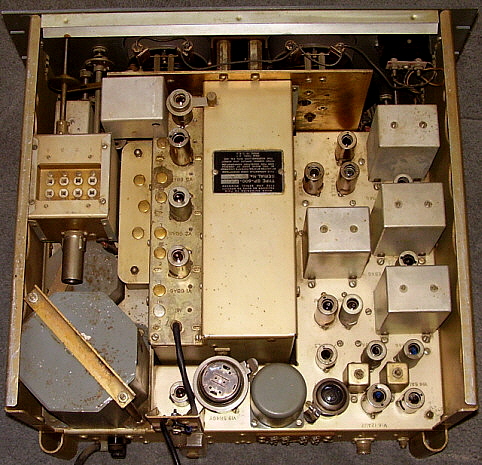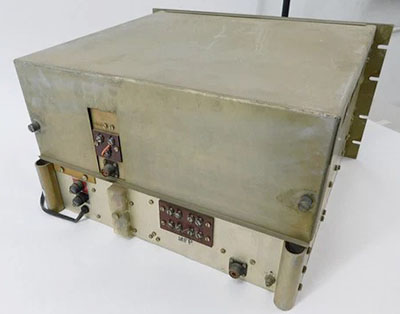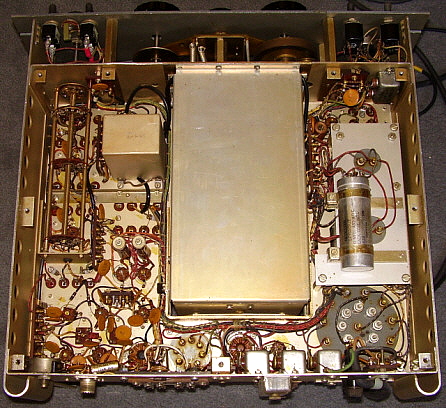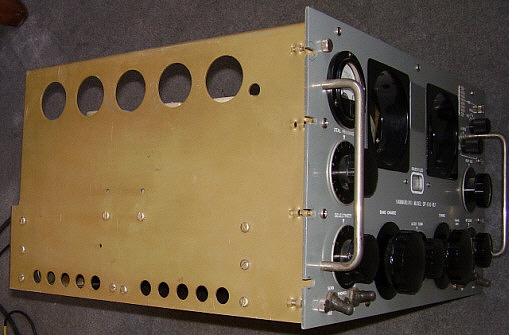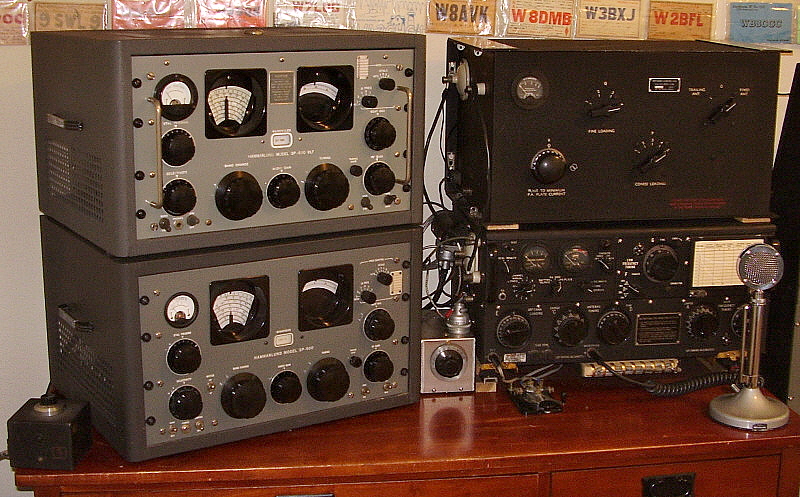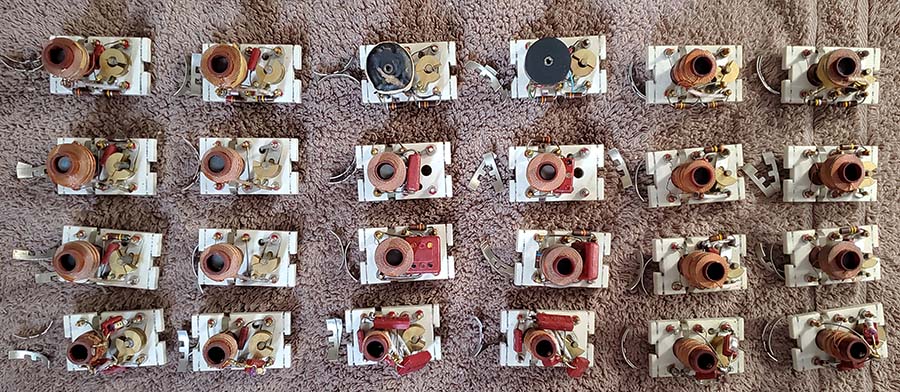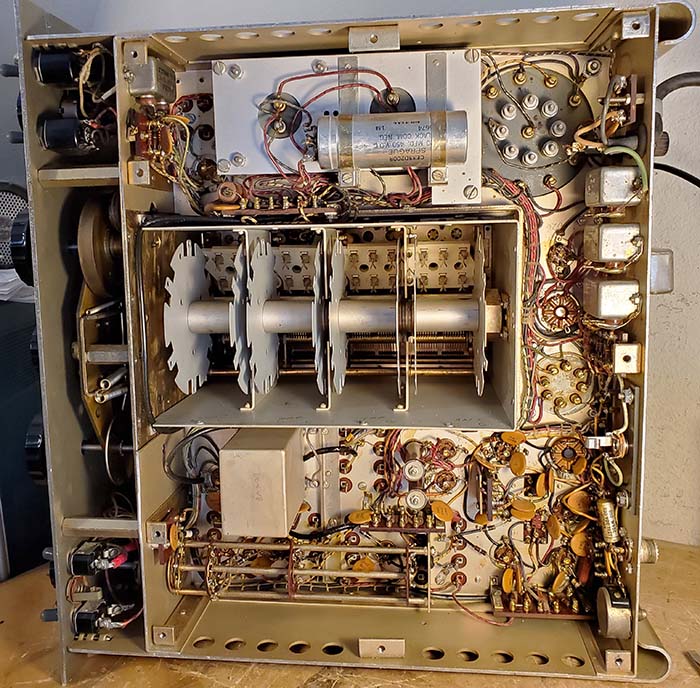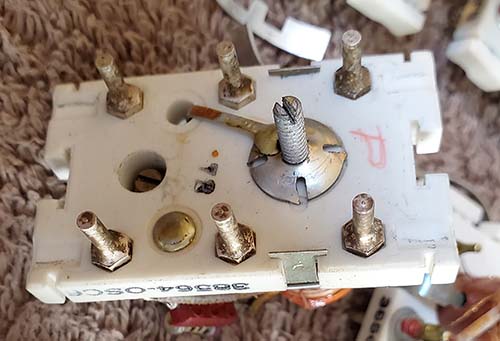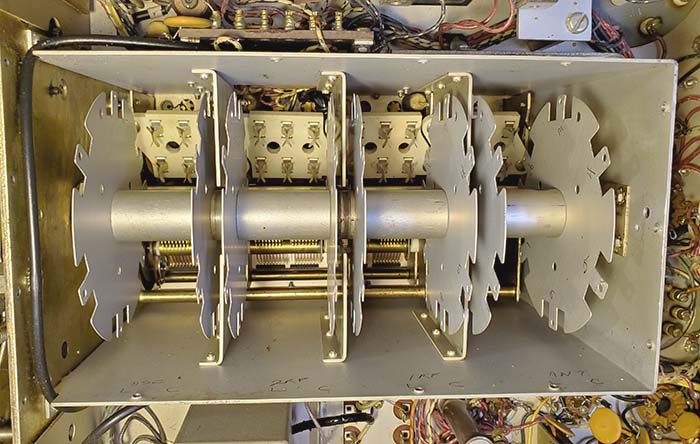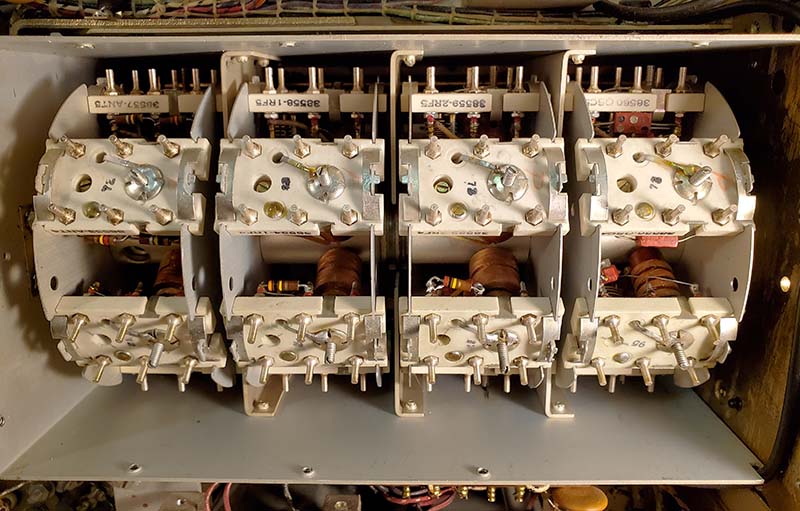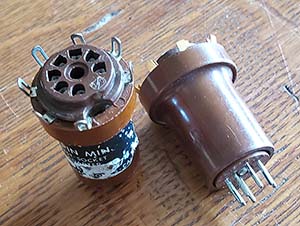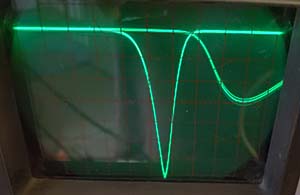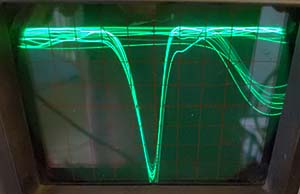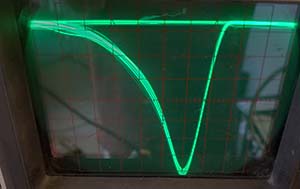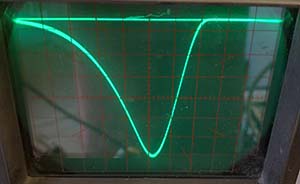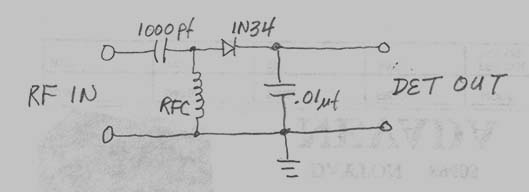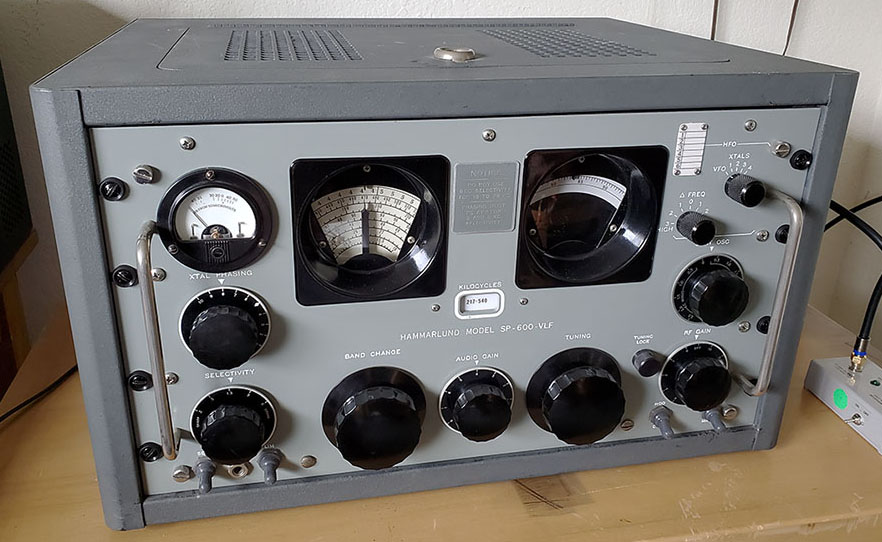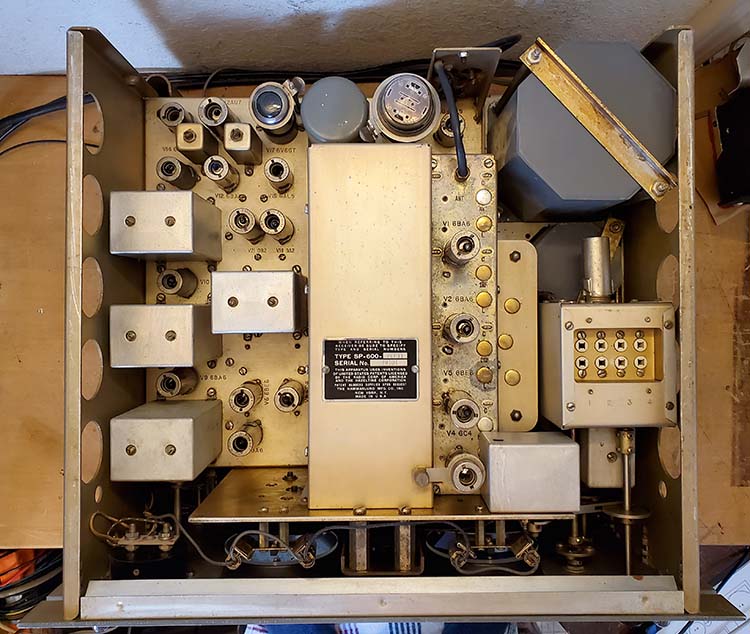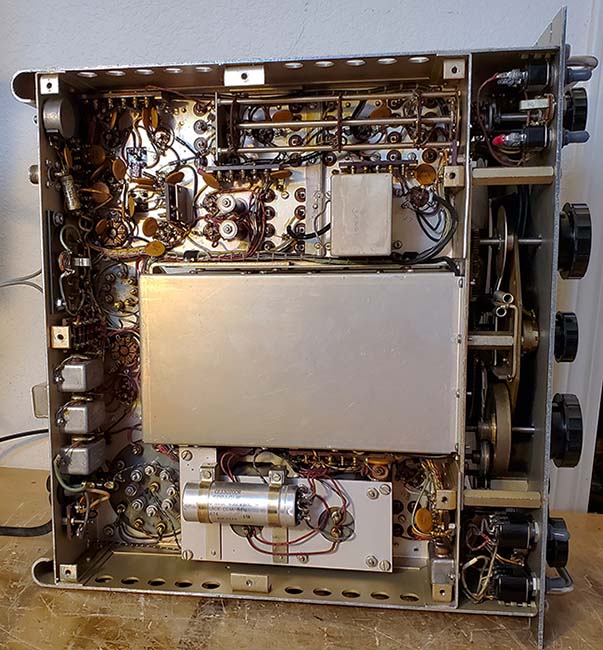|
Antennas - My first serious listening session was using my 80M Inverted Vee
antenna with the feed line shorted. I logged two newly-heard NDB
stations. Not that they were any great DX, being
PND 356kc in Portland,
OR and BF 362kc in Seattle, WA, but they were new ones (#259 and #260,
respectively.) I quickly switched to a homemade remotely
tuned loop that was six
foot diagonally. In Nov 2019, I
went to a shielded magnetic loop, the Pixel
Loop. The impedance of the Pixel Loop is 75Z which is a good match for
the SP-600-VLF's 72Z input impedance. The Pixel Loop was a significant
improvement in signal to noise ratio and with ease of operation (the
remotely tuned loop had to be "tuned" every few kilocycles,...often, in
other words.) As mentioned, weak signal reception on MW is very much
improved using a loop antenna. However, on LF and VLF, when using a long end-fed wire antenna, sometimes it's
advantageous to have an inline switchable attenuator between the antenna
and the receiver. This allows reducing intense signals (not that common)
but it also allows finding the best response between the large antenna
and the noise generated by everything that the large antenna responds
to. I use a switchable attenuator that can reduce the signal levels down to
-82db in -1db increments. I've
found that around -20db seems to greatly reduce the noise while the
signals are still heard. Of course, the shielded magnetic loop is much
better at reducing noise but below about 100kc the loops don't respond
very well and a long wire is needed. The switchable attenuator will help in that
kind of setup.
The following
are some of the signals that can be received below 500kc,...
LW-BC - At one time
the LW-BC band was from 190kc up to 280kc. It was primarily used in
Europe and in Asia but many of the stations ran such high power levels
to large antenna systems that their signals could be received here in
the USA. As technology advanced, it became obvious to radio engineers that the low RF frequency
versus the AM modulation somewhat limited the resulting audio bandwidth that
could be produced by LW-BC stations. The argument was that better
fidelity was available from other broadcasting sources (many of the
avid LW-BC listeners didn't care about fidelity and these devoted
listeners kept LW-BC going much longer than expected.) Another factor was the enormous
cost to operate these stations and the value of the real estate that the
antenna system needed. LW-BC has been on the decline for decades and, as
of 2024, it has all but disappeared from the LW spectrum (BBC-4 is
one of the few LW stations still on the air but they claim
unavailability of replacement parts will one day force them off the air.) Of the LW-BC
stations that could be heard in
the Western USA only Radio Rossii 279kc, located on Sakhalin Island and
running 1000KW, was an easy station to receive
(although one had to get up very early in the morning for a good
signal,...5AM was pretty good because Radio Rossii shutdown at 6AM
Pacific Time which was midnight on Sakhalin Island. Programming was
Russian Jazz music and news - in Russian.)
All other LW-BC stations were extremely weak so the tuning was done with the BFO
on and tuned to zero beat. This is called an "exalted carrier" type of
reception of AM and it sometimes helps with weak signals. Unfortunately,
all I could ever hear on the European LW-BC stations was the carrier and the modulation wasn't
detectable. NOTE: About Russian LW Stations
- Radio Rossii 279kc and all other Russian LW BC stations were
shutdown Jan. 9, 2014. As an update for 2024, there are no LW-BC
stations transmitting that I can receive here in the Western USA. In
fact, there are only a few LW-BC stations that are actually "on the air" with most LW-BC stations being listed as "temporarily not operating" or "on standby" or
other vague notations that actually indicate the station is "off the
air." Economics, cost of maintenance, lack of high-power tubes,
expense of new replacement equipment that doesn't exist and that other reception options
are available that can provide better fidelity are the usual reasons listed for the station
going "off the air."
NDBs - Although NDBs are MCW signals, all "NDB-chasers" use a BFO (tuned to
~ 400hz offset +/- from IF) to help locate the NDB carrier and then tune to zero beat
to copy the MCW (this method results in a nice sounding 400~ note
depending on the particular NDB station.) Best
results for NDBs has the AVC off, BFO on and riding the RF Gain control. Nearly all of the NDBs tuned in seem
to have two or three signals on each frequency (well, that was the
case years ago, nowadays it's a sparse NDB environment with the future of airport NDBs
being tenuous at best. Hundreds of NDBs have been and continue to be decommissioned each
year over the past decade and, since no pilots in the USA use NDBs for
navigation, there's little incentive for airports to keep their NDBs in
operation.) Most NDBs are transmitting from 200kc up to about
440kc. There are a handful that operate from 510kc to 521kc. The power
output of a typical NDB transmitter is about 25 watts although many run
up to 100 watts and there are a few regional NDBs that run a few hundred watts.
There are a few transoceanic NDBs that can run up to 2KW. Antennas
are usually simple wires that aren't very high since they are normally
right next to the airport runway. A few regional and transoceanic NDBs operate vertical antennas.
DDP 391kc is one of the last operating transoceanic NDBs. It's located
in San Juan, Puerto Rico and is
running 2KW to a very tall vertical antenna. DDP 391kc is very easy to
pick up here in the Western USA during winter-nights - about 3500 miles
DX.
630M Amateur Operation
- This ham band is 472kc to 479kc. Any mode can be used. CW ops were
supposed to use 472kc to 474kc and then data mode users had the top 5kc
- all a "gentleman's agreement" that usually doesn't really function
very well,...much to the detriment of CW operations. Maximum power
output is 5 watts EIRP which doesn't sound like much but since the
efficiency of most ham antennas at 630M is so poor, actual power to the
antenna might be hundreds of watts to achieve the 5 watts EIRP. The are
several 630M ham beacons in operation. More information in the 630M
section further down this article. There also is a 2200M (136kc) ham
band, any mode, 1 watt EIRP.
Master Station "M" Fallon, Nevada -
Loran-E - The new and improved Loran-E has started up in
July 2024. Master Station "M" is using the same 625' tall vertical with
the 900' diameter capacity hat. They are using the same 400KW Megapulse
transmitter operating on 100kc and they are naturally transmitting from
the same location at the end of Loran Road in Fallon, Nevada. The old
Loran-C was shut down in 2008 (politics, mostly) but it was soon
discovered that there was an "over-reliance" on GPS navigation and the
very low power signals from GPS satellites could easily be interfered
with,...intentionally. As personal computers became more and more
powerful it became easier and less expensive for determined hackers to
disrupt and create errors in the GPS data. By 2015, official legislation was enacted to
restart Loran since its very powerful signals and very low frequency of
operation just about eliminated the possibility of external corrupting
signals trying to jam the navigation information. Loran-E works the same
way that Loran-C did in that the timing of the arrival intersection point of the wavefronts from three different
Loran stations define the location of the Loran receiver that's usually
onboard ship. There's now an extra pulse in the signal that carries
additional data to further help the navigators and users of Loran-E.
Also, users that have the old Loran-C receivers can still use those
receivers since they will still function with Loran-E. The additional
data won't be accessible but the navigational information will be.
Loran-C (and now Loran-E) was also used for other purposes by many other
operators around the world. The timing of the signal from each Loran
station was precise
and controlled by three cesium atomic clocks at the stations and many
operations based their timing needs on Loran's timing. All of that type of use
is still available with Loran-E. Master Station "M" is only 50
miles to the east of Dayton Valley so the signal on 100kc here is
formidable and intensely strong,...a good test signal on 100kc,...I can
easily pick it up on a crystal set. Listen
for "tick, tick, tick,..." that is constant and never changes
and never stops,...just a constant "tick, tick, tick." Each "tick" contains nine
pulses that identify if the station is a "slave station." The "master
station" sends ten pulses to identify it as the "master." All Loran
stations are on the same frequency of 100kc and precise timing is
imperative for proper identification of the "master station" and the
three "slave stations." Station "M" is the Pacific Master
Station with (if it hasn't changed) one slave station "G" in George,
Washington. Another slave station "X" is in Middleton, California and
the last slave station is "Y" in Searchlight, Nevada.
NOTE: For those who remember
how the old Loran-C signal sounded, Loran-E is a much faster "tick,
tick, tick."
| LF Time Stations - In
the USA, WWVB is the best-known
LF Time Signal station, located in Ft. Collins, Colorado and
transmitting on 60kc. WWVB
transmits a 50KW pulse-encoded and simultaneously a phase-modulated time
signal that provides time-setting capabilities for compatible clocks. The
next easiest LF Time Station to pick-up is
JJY, located at Mt. Otakadayo, Japan, transmitting a
pulse-encoded time signal on 40kc. JJY
also transmits on 60kc. Like, WWVB,
JJY also transmits
phase-modulated information simultaneously.
JJY is the only LF Time Station that identifies itself in
CW which is sent at 15 minutes and 45 minutes after each hour (the CW ID
is sent twice each time.) Besides WWVB and
JJY, there are
several other "time signal" (both pulse-encoded and phase
modulated signals) stations located around the world. The most powerful
is ALS162/TDF in France running 800KW on 162kc.
ALS162/TDF is a former LW-BC
station that ran 1400KW (Yes! 1.4 megawatts.) When the LW-BC service stopped the station and
transmitter were converted to a phase modulated-type of time signal station (provides
clock time setting like WWVB.) The power was reduced to help conserve
the equipment and have a more economical operation.
ALS162/TDF is easy to receive
due to its tremendous power output but the time setting information is a phase modulated time signal
only. Phase modulated time signals sound
similar to a MSK signal. Phase modulation is used because much more
information can be encoded into the phase modulated signal compared to the
older pulse-encoded signal. There are also phase modulated time signal stations in
Germany DFC77 running 50KW on
77.5kc, UK MSF running 17KW on
60kc and Russia RBU running 10KW on
66.6kc. China BPC is running at
90KW on 68.5kc providing both pulse-encoded and phase modulated signals. Unfortunately, the UK station
MSF is on 60kc
like WWVB and the Russian station
RBU only runs 10KW, so picking
up these two stations is next to impossible here in the Western USA.
I've received all of the other time signal stations. The data
transmitted by these stations is for automatic self-setting clocks
and other such time-based devices so listening to these signals doesn't
provide much in the way of aural enjoyment. But since their frequency is
known and their location is known they do provide valuable test signals
for receiver-antenna performance and reception conditions. |

QSL card from JJY |
VLF Stations
USN Submarine Fleet Communications
- Stations
NAA,
NWC, NPM, NML and NLK are very strong MSK
(Minimum Shift Keying) Navy VLF stations in the 19kc to
25kc region of the spectrum. NAA 24.0kc
can run up to 2000KW while NLK 24.8kc
can run up to 1200KW. Both of these stations employ enormous array antennas to
go along with their tremendous power output.
NAA uses two trideco array antennas that are each
comprised of six panel "star shaped" umbrella arrays suspended by 26
towers that range from 1000ft to 600ft in height. Suspended just above the ground below the arrays are
the counterpoises that are the same size as the tridecos. The enormous
size of the NAA antenna system takes up an entire peninsula between two bays in
Cutler, Maine. NLK uses a dual
horizontal "W" array that is suspended from twelve, 200ft tall
towers that are placed up the sides of two mountains (Blue
Mt. and Wheeler Mt.) near
Oso, Washington. The dual horizontal "W" array spans across the valley
between the two mountains with ten vertical 900ft long drops that are
routed to twenty more towers on the valley floor that support the feed
line buss on one end and the ten feed line counter-weights on the other
end. The feed line buss routes the signal from the station house to the
antenna arrays. Each of the ten
antenna runs across the valley are between 8700ft to 5650ft in length
(each antenna leg span across the valley is over one mile in length!)
The entire valley has an enormous buried radial ground system that was
installed when the station was built in 1953. NPM
21.4kc
in Lualualai, Hawaii
and NML 25.2kc in La Moure, North Dakota each run 550KW to
a ground-isolated, 600ft tall vertical. Both verticals use large wire
capacity hats with isolators. NWC
19.8kc
runs 550KW to a single trideco array operating out of Exmouth, Australia. JJI
22.2kc is another MSK Sub-Comm station
that operates out of Obino, Japan (sometimes identified only
as "J.") MSK reception will require
that the receiver's BFO to be turned on. No information can be decoded
from these stations since the transmissions are multi-layered and
encoded so special equipment is required to reassemble the data and then the messages are encrypted, so "reading" anything is
impossible. The USN Sub-comm stations are useful
to LW enthusiasts in that their exact transmitting frequency is known along with
their location so they provide excellent strong test signals for the VLF region
of the spectrum. I've also heard regular FSK RTTY signals around 21kc
several times. Origin unknown. Other MSK signals will be heard from 19kc
up to around 50kc. Again, unknown origin. All of the USN Sub-comm
stations produce incredibly strong signals. Here in the Western USA,
NLK and
NPM are strongest. Then
NAA,
NML and finally,
NCW (but, even
NWC is usually a pretty strong
signal.) All of these stations are good test signals for VLF
reception,...day or night.
Russian VLF Navigation Signals -
ALPHA - RSDN-20
- The so-called "Alpha" navigation system transmits from three
major sites in Russia along with two other sites that are sometimes
used. The system uses many different frequencies that are all around
12kc, 14kc and up to 15.6kc. The signal consists of six 400ms duration
frequencies with a 200ms duration spacing. The signal duration is usually 3.6 seconds. Other times,
different combinations of coding are used, it seems to depend on maintenance and
other problems at the various stations. The primary Alpha
station is located at Novosibirsk. Secondary stations are at Krashodar and Komosomlsk-na-Amur.
All stations are in central Russia. There are two other locations
that are sometimes used at Revda (near Mirmansk) and Seyda. Power output is
500KW but details on the antennas used seems to be secret. What can be received usually
consists of "beeping" of the transmitted coded pulses that
if tuned correctly, two
different beep-frequencies will be heard,...sort of a "bee-boop"
sound. It was all typical "top secret" so not much is known about how the
system works, although it's thought that the Alpha system can be
used for aircraft navigation, maritime navigation and submarine
navigation. Since these are high-power stations in the VLF part
of the EM spectrum, they can be received day or night, if they
are actually transmitting. There are constant rumors that the
entire system is going to be shutdown but it still seems to be
running. Last reception here was 12/24/2024 during both daytime and
at night. The signal was only a single "beep" with about a five
second pause and then another "beep." No "bee-boop" like the
running or operational Alpha signals. Perhaps the system was
down for maintenance. If one station goes down, the entire system
doesn't work, so maintenance is a constant problem. The 12/24/24 "beeps" were on 12kc, 14kc and 16kc
approximately. From my reception location in the Western USA, the
"Alpha" signals are moderately strong and are about the same
strength as the USN-MSK station NWC 19.8kc located in Exmouth on
the coast of Western Australia (NWC runs 550KW to a Trideco
Array antenna.) There is some information on the
Internet,...search "Russian Alpha Navigation Signals" for more
details. Since the RSDN-20 signals are VLF and can be
received day or night, they are good lower-level test signals.
SAQ Grimeton, Sweden 17.2kc
- SAQ is the only operational Alexanderson Alternator, a mechanical
transmitter, in the world. When it
was new, it could run up to 200KW on 17.2kc in the CW mode but, due to the
transmitter's age, it now can run about 160KW but for conservation
purposes it normally is run at 85KW. The SAQ antenna is
enormous and consists of eight horizontal wires supported by six 425ft
tall towers. There are six vertical drops that connect to loading coils
to match the antenna load to the transmitter. These loading coils were
rebuilt a few years ago and now the antenna is running at about 10% efficiency so the actual radiated
power is 8.5KW (but actually it's probably even less than that due to
other losses in the system and the environment.) When the antenna
was new, the efficiency was rated at 14%.
SAQ is "on
the air" at least two times during a year. Christmas Eve and Ernst Alexanderson's
Birthday (in June.) Although the recent antenna loading coil work may
have improved the signal with better matching and loading capabilities,
still the signal reception in the Western USA, using vintage longwave radio
receiving equipment and human ears listening, is virtually
impossible. Most USA reception reports are using modern SDR (Software
Defined Receiver) receivers or other types of receiving equipment
with computer driven visual panadapter
spectrum displays and
computer recording capabilities (allows repeated playbacks for
analysis) rather than actual human listening in "real-time" to an
operating vacuum tube longwave receiver connected to a large wire array
antenna. Compounding the difficulty of "real-time" reception is that the
transmission from SAQ is at 9AM Christmas Eve morning over in Sweden,...that's
0000hrs midnight on the West Coast of the USA (nine hours earlier
- the ability to do a "timed" recording of the transmission would a
definite advantage in many ways.) I've never "clearly" received SAQ
in the many listening sessions I've tried. I've heard a few CW letters but nothing that
could definitely be identified as coming from SAQ (extremely weak, in
the noise and maybe in my imagination.) Yet other VLF signals within
a few kilocycles above and below 17.2kc are clearly received with
relatively strong signals. This shows that the capability of world-wide
VLF reception using "real-time" listening on vintage vacuum tube
receiving equipment connected to a large wire array is a reliable
possibility but it depends on the transmitting station's antenna system
and the transmitter's power output.
SAQ UPDATE: Dec 23-24,
2024: I tried listening for SAQ last night at 0000hrs. I
haven't tried this since the SAQ antenna work was performed, so I
thought maybe my chances might be better this Christmas Eve Day at
midnight. However, the report is exactly the same. Nothing definite,
some CW letters (maybe) but no words or call letters. SAQ sends a series
of "V" characters and multiple "SAQ" IDs before the
actual message transmission begins and
this wasn't heard. At only 8.5KW radiated power, from Sweden, on 17.2kc,
"real-time" reception seems unlikely (but I gave it a try anyway.) I did hear quite
well (and fairly loudly) the Russian RSDN-20 nav-signals on 16kc (also on
14kc and 12kc - running 500KW.) Also, NWC USN MSK Sub-comms station on 19.8kc from
Exmouth, Australia was very strong (NWC was so strong I had to use
the receiver's crystal filter to null out NWC's "bleed-over.") NWC runs 550KW to a single trideco
"umbrella array" antenna system,...and that illustrates the SAQ problem,...not enough power and
an inefficient antenna system. SAQ and its antenna system were originally
designed in 1924 for reliable communications with Great Britain and the USA
Northern East Coast, not world-wide
communications,...not then and certainly not a century later.
|
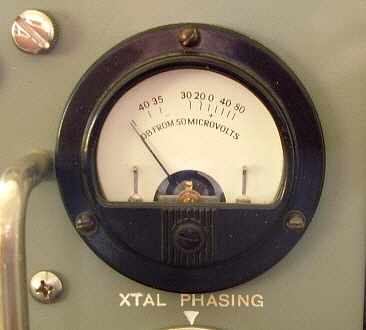
The carrier level meter is unique
to the SP-600-VLF |
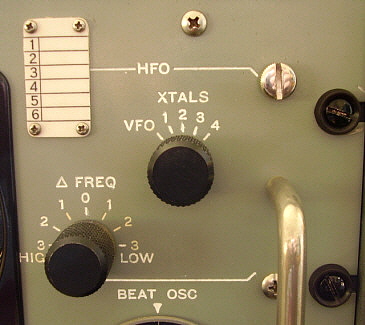
Only four crystal positions are
offered in the X option |
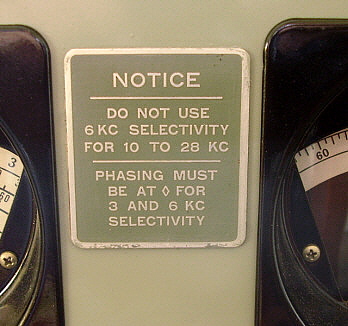
Tag between the tuning and logging
dials |
|
No receiver is perfect, so here are a few
"negatives" about the SP-600-VLF31 |
|
The SP-600-VLF31 Manual - Absolutely One of the Worst |
If
you're expecting the SP-600-VLF manual to be as detailed and comprehensive as the
manuals Hammarlund produced for the HF
versions of the SP-600JX you'll definitely be disappointed. As mentioned
in this write-up's introductory sentence, the first "questionable writer qualification"
happens right off when it's stated that the SP-600-VLF tunes down to an
"audio frequency of 10kc." Well, it doesn't stop there but only gets
worse. The first significant problem is that there aren't any
under-the-chassis component location drawings at all. There's a basic "top view" of the
chassis drawing that shows tube locations and transformer identification
but nothing to locate smaller individual components under the chassis.
There are photographs of under the chassis but nothing is
identified so these are no help for troubleshooting. If a specific component
location is required it becomes necessary to use the schematic and tracing the
wiring (sometimes using an ohm meter) to find the specific component location.
There are several component boards used under the chassis and there
aren't any drawings or photos to show or identify the components that are on any of
these boards - you just have to trace the wiring yourself to find out. All of the HF SP-600JX manuals
contained detailed wiring diagrams that illustrated exactly how the
receiver was wired, showing wire routing and connections plus showing
all of the component locations and how they were connected into the
circuitry. Usually there
were at least two wiring diagrams because so much detail was shown it couldn't
all fit on just one drawing (Hammarlund had to provide these drawings
since they were selling so many HF SP-600s to the military.) Not so with the "VLF" manual since there isn't a
wiring diagram at all - nothing! If
you take out the RF coils (and don't pay attention) there isn't any
information in the manual on how to correctly reinstall them. On and on,...only the
bare minimum of information is supplied. As far as written circuit
descriptions, they're detailed and very usable. At least Hammarlund
provided a tube pin voltage/resistance chart and the disassembly
instructions are good. Perhaps there was a
separate "Maintenance
Manual" for the SP-600-VLF that provided all of the expected (but
absent) information,...but I've never seen or heard of one.
By Far, the Worst Alignment Procedure
Ever Written - However, the "all-important" alignment procedure is
absolutely awful,...positively one of the worst and most unusable set of
instructions I've ever encountered. The alignment procedure reads as if somewhere in the Hammarlund
organization it was stated by one of the "higher-ups" that the "600-VLF"
alignment had to be "the most accurate alignment possible." So, the writing
task was assigned to an engineer that had never performed an actual
receiver alignment and,...since "best accuracy" was the goal,...that
had to achieved regardless of the practicality of implementation or the
time necessary for performing such an alignment or the amount of
collateral damage brought about by the alignment. While sweep aligning the IF
is definitely the best method to achieve symmetrical passbands, you
shouldn't have to go out and BUY
special equipment to perform the job (the manual actually gives the
name of the company and their address where you could purchase the
specified special equipment - incredible!) And, you shouldn't have
to unsolder components in the receiver circuitry to accomplish the
alignment,...unbelievable.
Unsoldering
Components for an Alignment?
You Must be Kidding!
- The necessity of unsoldering the "loading resistors"
in the RF front-end is totally impractical. It requires removing each
of the two RF coil assemblies (ANT and 1RF) from the turret on each of
the six bands first to unsolder the resistors. Then the coils are reinstalled in the turret and a RF
signal injected at the antenna input. Then a RF Probe-VTVM are used to
measure
maximum RMS voltage at the 1st and 2nd RF Amplifier tubes for alignment. Then the RF coil assemblies have to be removed
again, the load resistors resoldered and the RF coil assemblies reinstalled. That's
12 RF coil assemblies that are "in and out" of the turret four
times,...what an "exercise in potentially causing
receiver
non-functionality due to
component damage."
Simply unbelievable! In addition to the RF Probe-VTVM RMS measurement, the procedure
requires other special equipment that's not always available, e.g., a
sweep generator, the "special order" dual sweep trace oscilloscope (dual X vs Y inputs)
with a special detector probes to allow the ability to monitor both the
sweep input LC and the sweep output LC of the IF transformers
simultaneously while sweeping to allow finding coincidence,...on and on.
For every section of the receiver, the alignment procedure is overly
complicated requiring that certain components or wires be unsoldered from the circuit and then requiring
special equipment. There are so many components and/or wires that
are disconnected, rerouted, then the measurement/alignment performed and
then the component or wire reconnected it
would be a miracle if the components or wires could or would be returned to
their correct connections. The physical damage that's very likely
to happen with the action of unsoldering component leads and wires, then
reconnecting and soldering the parts back in place makes one cringe. The
amount of components that are tampered-with in the alignment procedure
is staggering beyond belief!
Why Publish a Useless Alignment
Procedure?
-
It's almost a certainty that any SP-600-VLF receiver would have been
initially owned by either commercial users, such as laboratories,
communications or monitoring businesses or possibly by the military. One
can confidently rule out any ownership of a SP-600-VLF by any amateurs.
Since ALL professional and military equipment would usually be aligned by
professional technicians, one would think
that the alignment procedure would have been written at "tech-level"
to allow each alignment to proceed along quickly and accurately. All of the HF
SP-600JX manuals, because those receivers were used extensively by the military, have easy to follow tech-level alignment procedures
with no special equipment required. Hammarlund should have
employed someone experienced in writing tech manuals to write this
section of the 600-VLF manual (or, to keep it simple,
just hire one of the Army Signal Corps TM manual writers.) So, why would
Hammarlund even publish this impractical alignment procedure? I'm sure
that if the SP-600-VLF had been sold in any quantity to the military, there
would have been an entirely different, Signal Corps military-style technical manual that
would have been available, similar to the HF SP-600JX TM11-851 manual. But, since civilian
purchasers from laboratories or commercial monitoring services, etc., were the
likely end-users, commercial technicians would be performing receiver
maintenance and that included alignments. But why would commercial techs
be expected to use this
"impossible to perform" procedure? In reading
the SP-600-VLF alignment procedure MANY TIMES, I've come to the
conclusion that Hammarlund didn't want anyone going into the
receiver to make adjustments and they wrote a procedure that
assured that NOBODY would even consider aligning the
SP-600-VLF per the manual. Perhaps Hammarlund wanted all SP-600-VLFs
returned to the factory for any type of repairs or maintenance and an
obtuse alignment procedure made sure of that. But, I'm sure that even Hammarlund
didn't align the SP-600-VLF as
described in the manual (so, what should you do? Read on,...)
Does the Alignment Procedure in the
Hammarlund SP-600-VLF Manual have to be Used? - In looking at the schematic of the
SP-600-VLF, it's obvious that it's a standard single conversion superheterodyne. There's
nothing special going on in the circuits. It can (and should) be aligned
just like any other superheterodyne. The bulk of the receiver circuit
operates at 705kc. Use 705kc for the IF. For the best results, sweep
align the IF. First, "peak align" at 705kc and then apply the sweep signal
at the grid input on each IF stage and do minor tweaks to the
appropriate IF transformer for the best shaped passband. Proceed from
the last IF to the Mixer always with the 'scope on the
detector output, the Diode Load (this is basically how a standard sweep IF alignment is performed,...more
details on sweep aligning the IF of the SP-600-VLF in the "2024 Workbench Visit" at towards the
end of this article.) The turret coil assemblies
function at various other lower frequencies than the IF. A RF signal
generator (or a very stable Function Generator) that can produce a RMS
voltage output down to 10kc is necessary. Adjust the
turret coils as if it were a HF SP-600JX but use the frequency table in
the manual (at least that part of the alignment procedure isn't corrupted.) Align the BFO and the Amplified AVC to
705kc. Adjust the 455kc IF conversion for maximum output at the IF
OUTPUT. Use a VTVM on the Diode Load and adjust for peak negative DC
voltage with the AVC off.
What is interesting is that my detailed
inspection under the chassis of the entire SP-600-VLF receiver and
detailed RF coil assembly inspection revealed that NONE of the
components or wires that were supposed to have one end unsoldered and
"lifted" had EVER had the original solder joint disturbed. That
indicates that whomever performed the maintenance on this SP-600-VLF
read the alignment procedure in the manual and knew it was unusable and
probably aligned the SP-600-VLF using conventional RF-IF alignment
techniques. And, this was probably the method used for several
alignments over the years. So, don't be afraid of the SP-600-VLF,...it's
a standard single conversion superhet that can be aligned like any other
similar type of receiver. Yes! I've aligned my SP-600-VLF, including a
sweep alignment of the IF, following conventional procedures and the
receiver functions great.
NOTE for HF SP-600 Owners: What a surprise!
The High Frequency SP-600 JX Instruction Book's Alignment Procedure really isn't a
lot better than the VLF's alignment procedure,...but at least you aren't
instructed to unsolder wire or components as part of the alignment. Although the peak IF
alignment is complete, if one wants to sweep align the IF, only two
sentences comprise the entire sweep procedure. In TM11-851, the same
special equipment is called out for the sweep alignment as is called out
in the VLF procedure (and the address is again provided.) But, TM11-851
does have the complete peak alignment instructions. At least the HF SP-600
Instruction Book's IF peak alignment procedure
is easy to follow and quick to perform. It's probably how almost all HF SP-600s
were aligned anyway. SO,...for those interested and who are owners of
any of the HF SP-600 receivers, I've added a complete IF sweep alignment
procedure for the HF SP-600 to the "Hammarlund SP-600
Receiver" write-up. No special equipment other
than a sweep generator and XvsY 'scope. Use Home-Index for navigation.
|
More
Issues,...but these are minor ones |
Dial Slippage - a Chronic Problem with all
SP-600 receivers (but
there's an easy solution) - All SP-600 receivers mechanically drive the tuning using the same set
up. A brass drive wheel is rotated with the Tuning knob. This wheel in
turn drives, by friction, a brass reduction wheel that is spring-loaded
against the drive wheel. The reduction wheel is grooved and mates with
the Logging dial driving it, by friction, at its perimeter. Driving the
Logging dial shaft tunes the receiver tuning condenser through the
gearbox. If
contaminates are allowed to accumulate on the friction drive surfaces
eventually dial slippage will be the result. Although some SP-600
enthusiasts believe that the "S" spring used for loading the reduction
wheel causes the slipping, I've seldom had just the spring be
responsible for dial slippage. Almost always, dirt and grease will have
collected on the friction surfaces of the brass wheels or on the rim of
the Logging dial and this is what is causing the slippage. Thorough
cleaning is necessary to correct the problem. Fortunately, all parts are
accessible without any disassembly. The brass wheels can be accessed
with the receiver on its side and the Logging dial rim can be accessed
from the top. Clean all friction surfaces with denatured alcohol. I use
several Q-tips to clean the brass wheel surfaces. Repeat the cleaning
until the Q-tips don't turn black. On the rim of the Logging dial, I use
a small piece of paper towel that is dampened with denatured alcohol.
Again, clean until the towels don't turn black. Remove and check the "S"
spring. It should be straight or slightly bent out. If it's bent inwards
then the spring load will be somewhat reduced. You can expand the "S"
spring by just bending it outwards with your fingers. Reinstall the "S"
spring. As an added help, check the rotation of the logging dial and how
much resistance to movement there is in the gearbox. Years of storage
with no use or no
maintenance may dried up any lubrication. It would certainly help to lubricate all of the shaft bearings with a drop
or two of
10W machine oil. As always, don't "over lubricate" and just apply
a drop or two of machine oil only where needed. Also, check that the Dial Lock is completely open and
not "dragging" on the Logging dial. Check the SP-600 tuning now. It
should not slip and should be "velvet smooth."
UPDATE: Jan. 1, 2018
- The slipping dial is back. Although I haven't pulled the receiver out
of the cabinet I can see what I think is the problem. The logging dial
rim has a small gouge that I think is causing the slippage since this
"dent or gouge" changes the dial friction in the drive wheel groove when
the gouge comes around. I also noticed that the logging dial has a
significant bend so it isn't really engaging into the drive wheel groove
with the same "fit" each revolution of the drive wheel. To repair this
will be a receiver out of the cabinet and front panel off since I'll
have to dismount the logging dial for straightening and repair of the
gouge. I'll do this after the Longwave season is over - probably around
March.
UPDATE: May 1, 2018
- A Solution That Works and isn't Difficult to Implement
- Slipping dial issue required pulling the receiver out of the cabinet
and then disassembling to the point where the front panel could be
removed. The dial lamp assembly over the logging dial has to be removed.
Then the three screw mounting plate is removed and the logging dial can
be removed. Close inspection revealed that near "45" on the dial rim
there was a deformation that had a "lumpy" feel to it. Also, between
"50" and "55" was another rough area. I carefully dressed these areas
with a very fine jeweler's file. The dial also had a warp that was easy to take out
with minor flexing of the dial. Upon reinstalling the dial on the hub, I
found that the slipping was still happening in the same areas. I
readjusted the "S" spring for a greater load against the drive wheel. No
improvement.
The Slipping Dial Solution - I thought about how improve the "grip" of the brass against
brass surfaces and came up with the idea of using rosin. I dissolved some powdered
rosin in some denatured alcohol to make a thin (viscosity like water)
mixture. I used a small paint brush to apply the rosin mixture into the
drive wheel groove. Then I rotated the logging dial to transfer some of
the rosin mix to the rim of the dial while applying more rosin to the
groove with the paint brush. I let the mix dry (alcohol
evaporates.) That did it. No more slipping - none at all! I didn't need much
rosin-mix, just a little brushed just into the drive wheel groove worked
great. If the rosin somehow disappears from the drive wheel groove in
the future, it's very easy to reapply the rosin-mix. Hopefully, the
"grip" will last for quite awhile. NOTE: The rosin-mix probably should be
reapplied each year for best results. For an update on the
rosin/alcohol mix read the update for Jan 6, 2021 further down this
page.
Jan 3, 2021 - Maintenance Required - I had been noticing that
changing the SELECTIVITY would cause signal loss and erratic reception. The problem turned out to
be in the SELECTIVITY switch that apparently I'd never cleaned. De-Oxit
and a small paint brush (and cleaning out a few spider webs) got the
switch operating fine. This seemed to clear up the problem. This is a
common problem with the HF SP-600 also. I've noted that for quite a while now
the dial is again slipping. Not nearly as bad as before but it's getting
worse. More rosin/alcohol mix needs to be applied to the drive wheel.
UPDATE: Jan 6, 2021
- More Rosin
- The rosin mix was still working fine in the small groove of the idler
wheel that actually drives the dial. The beveled drive wheel that
interfaces with the idler wheel was where the slipping was happening
since I hadn't ever applied the rosin mix there. I cleaned the bevel
with alcohol and several Q-tips turned black indicating dirt or
contamination of some type. Just cleaning the bevel gear helped with the
slipping but I applied new rosin/alcohol mix to ALL drive surfaces this
time. After the rosin mix dried, no slipping. Just as another
precaution, I adjusted the spread of the "S" spring for the dial drive.
This increases the engagement force of the idler wheel into the bevel of
the drive gear. The dial drive now seems excellent with no slipping.
We'll see how long this lasts - I think I can probably go about two
years between the "rosin" treatments - not bad,...it's an easy
fix. NOTE: I've actually gone three and half years and still no
slipping - 2024.
Shielded Magnetic Loops
- The SP-600-VLF does tend have a high noise floor that makes using
certain types of wire antennas in the MW and LF spectrum nearly impossible.
Best performance on MW with my SP-600-VLF has ALWAYS been with a loop
antenna. At first, I was using a homemade remotely tuned loop that
worked very well. I switched to a Pixel Loop in November 2019 and it
also works quite well. My Pixel Loop was purchased used and it's an old
one that was actually built by Sirius years ago. Nowadays, Pixel Loops
are still available but the disadvantage is not only the expense of a
Pixel Loop (about $800) but they always seem to be on "back order."
Pixel Loops are available from DX Engineering but expect to wait for
actual delivery. The other good LW loop was the Wellbrook Loop.
They came from the UK but now Wellbrook is out of business. Wellbrook Loops are
frequently seen for sale "used." The Wellbrook
Loops seemed to have problems with their LNA although, when they were
still in business, they would replace them if the failure was component or workmanship
related and they could be purchased separately, if needed. I've seen
replacement LNAs for sale by private owners on eBay. Chameleon also made a high quality shielded magnetic loop a few
years ago but it was mainly for HF and didn't perform as well as
expected on MW or LF (this opinion was expressed in an Internet
review of the Chameleon loop.) There are other
much less expensive loops that are made out of coax for the loop portion
using the coax braid for the shield and the center conductor for the
antenna. These type of shielded magnetic loops are from W6LVP and they
are mainly designed for HF, so MW and LF may not perform as well as expected
(again, this was an Internet opinion and my experiments show that the
signals start dropping off as the AM-BC band is tuned through.) Also, these coax loops aren't
particularly durable when used outside (also Internet opinion.)
As an indoor loop they might be an inexpensive alternative. The coax
loops are about half the price of a Pixel Loop at $345.
NOTE 2024: I've had the
Pixel Loop since 2019. I was just given a W6LVP loop in 2024. This gave
me the opportunity to test both loops "side by side." Throughout the HF
spectrum, that is from 3mc to 30mc, both loops' performance is nearly
identical.
Through the AM-BC band, the W6LVP loop begins to have minor losses but the Pixel
Loop remains at the same performance level. Below 500kc, the W6LVP loop
will pick up some stronger longwave signals but no MW DX, so the signal
loss is noticeable. The Pixel Loop maintains the same performance level down
to 100kc and I've even used it down to 24kc for the USN VLF stations, of course,
signal losses are noticeable but those USN stations produce very strong signals. I'd rate the W6LVP loop as very good for HF
but not so good below 500kc and, in fairness, it's spec'd as a loop
for 160M to 10M operation so expecting it to function well below 500kc
isn't how the antenna was designed, manufactured or advertised. The
Pixel Loop is spec'd from 30mc down to
150kc.
Homemade Remotely Tuned Loops
- These types of loops are not difficult to build and their performance
is usually a vast improvement over a wire antenna. Finding the MVAM-108 varactor
diodes (bias voltage changes the capacitance for remote tuning) might be
difficult nowadays. If the MVAM-108s can be found then building a
remotely tuned loop is easy and the bias voltage can be provided by a 9
volt battery and a high resistance 10K potentiometer with 1 meg isolation
R. A switch is necessary to isolate the battery when the loop isn't in
use.
Plans for a remotely tuned loop are in Part
4 of "Vintage Long Wave
Receivers." Use Home/Index at the end of this article for
navigation.
Dual Crystal Filters - The Selectivity options are limited because the Band Pass crystal filter and
the Phasing crystal filter that
are always in the circuit for every selectable bandwidth, even the 6kc
bandwidth. Nowadays, there are virtually no Voice-Music signals being
transmitted below 530kc. The only possibilities for music would be on
540kc AM-BC and for Voice on 530kc public service broadcasting. I haven't heard the TWEB NDB RWO
394kc from Alaska in a couple of years. TWEB NDBs transmit Voice weather
with MCW ID. RWO has probably been
decommissioned. LW-BC
is nowadays (2024) limited to just a couple of stations that
can't be received in the western USA. So, there really aren't any
Voice-Music stations transmitting that would benefit with a non-crystal
filter IF bandwidth position. The Crystal Filter operates differently
than a typical crystal filter in that the entire rotation from 10 down
to 0 on the PHASING dial scale varies the bandwidth from maximum (10) to
minimum (1.) There is also a very narrow peak that moves around the
passband as the PHASING control is rotated that can be used for peaking
a particular heterodyne tone in CW. The first Crystal Filter is
essentially non-adjustable and is actually a crystal-controlled Bandpass
Filter centered at 705kc.
Dial accuracy is
typical of non-Collins gear from the 1950s. The accuracy is very good
(after an alignment) but the dial resolution could be considered vague. With the inclusion of
the Logging Dial it's obvious that Hammarlund expected extreme accuracy to
be determined with a Heterodyne Frequency Meter and then the Logging
Dial used for accurate frequency reset. All typical of 1950s
designs, so this is not unexpected.
Hard to Access BFO Tube
- Accessing the BFO tube will require removing the shield-box over the
LO switch for the Crystal Oscillator. There's a hole at the back of the
shield-box that allows access to the mounting screw. Don't remove the
screw,...just loosen it. Then the shield-box can slide upwards (it's a
long slot that the screw works against) to clear the screw. With the switch shield-box
dismounted, now there's easy access to the BFO tube although a
long-handle tube puller might make removal of the tube a bit easier. When BFO
tube testing is completed and a good tube installed, then reinstall the
LO switch shield-box. When aligning the receiver front end, this
shield box has to be removed to allow access to the OSC L-C adjustments.
Hammarlund SP-600 Cabinet Rack
Mounting Screws, Straps and Holes - The eight holes for
the rack screws to mount the receiver into the cabinet don't have any
threads. In fact, they're just .250" diameter holes. Instead, a steel
strap with four 10-32 tapped holes is placed behind the cabinet holes with the
receiver in place in the cabinet. Reaching around the top side of the
receiver side panel, the steel strap can be moved around with the
fingers (sort of.) The tapped holes have to be aligned with the
cabinet holes and with the receiver rack notches. Then one of the 10-32 rack
screws can be hand-threaded into one of the strap holes. Once one screw
is threaded in then the strap won't fall and the other three screws can
be installed. This maneuvering of the steel strap to align with the
cabinet holes has to be repeated for the other side. Once all eight screws are
threaded in they can then be "snugged" - that is, not
over-tightened. These two steel straps really are time-consuming to deal
with and many times in trying to get the strap holes aligned with the
cabinet holes you'll end up dropping the strap and it will fall to the
bottom of the cabinet. That requires pulling the receiver out of the
cabinet to retrieve the strap, which is a real pain. Though I haven't
done it, I've thought about drilling two holes in the cabinet rack
mounting flange to accept 6-32 flat head screws. Then drill and tap the
strap (6-32) so that the mounting of the strap has the four rack 10-32
holes aligned with the cabinet .250" diameter holes. The flat head
screws wouldn't interfere with the receiver mounting and the straps
would always be aligned correctly and couldn't fall down inside the
cabinet. A good idea,...I just haven't done it yet. Just in case you
think that clip-nuts could be used, the dimensions are slightly
different. To use clip-nuts would require enlarging the cabinet's screw holes.
Once that's done, then the clip-nuts will work.
|
